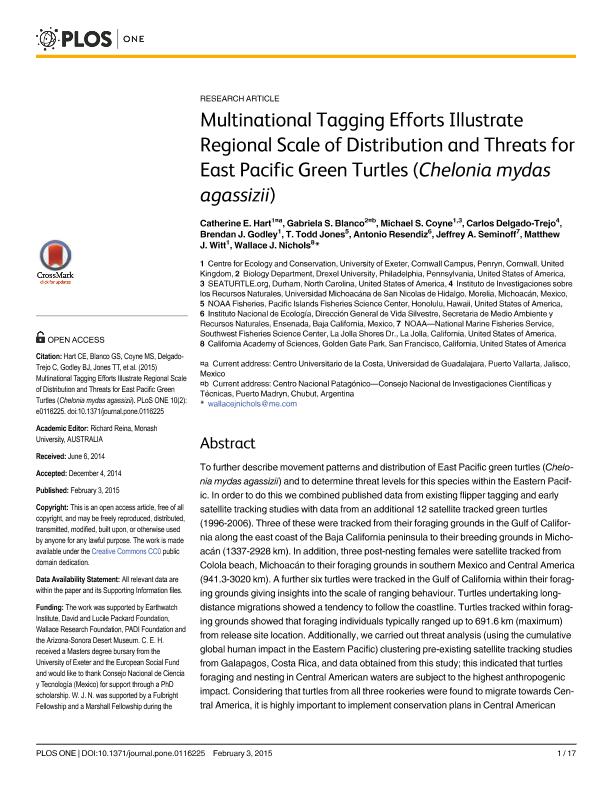Artículo
Multinational Tagging Efforts Illustrate Regional Scale of Distribution and Threats for East Pacific Green Turtles (Chelonia mydas agassizii)
Hart, Catherine E.; Blanco, Gabriela Silvina ; Coyne, Michael S.; Delgado Trejo, Carlos; Godley, Brendan J.; Jones, T. Todd; Resendiz, Antonio; Seminoff, Jeffrey A.; Witt, Mathew; Nichols, Wallace J.
; Coyne, Michael S.; Delgado Trejo, Carlos; Godley, Brendan J.; Jones, T. Todd; Resendiz, Antonio; Seminoff, Jeffrey A.; Witt, Mathew; Nichols, Wallace J.
 ; Coyne, Michael S.; Delgado Trejo, Carlos; Godley, Brendan J.; Jones, T. Todd; Resendiz, Antonio; Seminoff, Jeffrey A.; Witt, Mathew; Nichols, Wallace J.
; Coyne, Michael S.; Delgado Trejo, Carlos; Godley, Brendan J.; Jones, T. Todd; Resendiz, Antonio; Seminoff, Jeffrey A.; Witt, Mathew; Nichols, Wallace J.
Fecha de publicación:
02/2015
Editorial:
Public Library Of Science
Revista:
Plos One
ISSN:
1932-6203
Idioma:
Inglés
Tipo de recurso:
Artículo publicado
Clasificación temática:
Resumen
To further describe movement patterns and distribution of East Pacific green turtles (Chelonia mydas agassizii) and to determine threat levels for this species within the Eastern Pacific.In order to do this we combined published data from existing flipper tagging and early satellite tracking studies with data from an additional 12 satellite tracked green turtles (1996-2006). Three of these were tracked from their foraging grounds in the Gulf of California along the east coast of the Baja California peninsula to their breeding grounds in Michoacán (1337-2928 km). In addition, three post-nesting females were satellite tracked from Colola beach, Michoacán to their foraging grounds in southern Mexico and Central America (941.3-3020 km). A further six turtles were tracked in the Gulf of California within their foraging grounds giving insights into the scale of ranging behaviour. Turtles undertaking longdistance migrations showed a tendency to follow the coastline. Turtles tracked within foraging grounds showed that foraging individuals typically ranged up to 691.6 km (maximum) from release site location. Additionally, we carried out threat analysis (using the cumulative global human impact in the Eastern Pacific) clustering pre-existing satellite tracking studies from Galapagos, Costa Rica, and data obtained from this study; this indicated that turtles foraging and nesting in Central American waters are subject to the highest anthropogenic impact. Considering that turtles from all three rookeries were found to migrate towards Central America, it is highly important to implement conservation plans in Central American coastal areas to ensure the survival of the remaining green turtles in the Eastern Pacific. Finally, by combining satellite tracking data from this and previous studies, and data of tag returns we created the best available distributional patterns for this particular sea turtle species, which emphasized that conservation measures in key areas may have positive consequences on a regional scale.
Palabras clave:
East Pacific Geen Turtles
,
Eastern Pacific
,
Risk Assesment
,
Conservation
Archivos asociados
Licencia
Identificadores
Colecciones
Articulos(CCT-CENPAT)
Articulos de CTRO.CIENTIFICO TECNOL.CONICET - CENPAT
Articulos de CTRO.CIENTIFICO TECNOL.CONICET - CENPAT
Articulos(SEDE CENTRAL)
Articulos de SEDE CENTRAL
Articulos de SEDE CENTRAL
Citación
Hart, Catherine E.; Blanco, Gabriela Silvina; Coyne, Michael S.; Delgado Trejo, Carlos; Godley, Brendan J.; et al.; Multinational Tagging Efforts Illustrate Regional Scale of Distribution and Threats for East Pacific Green Turtles (Chelonia mydas agassizii); Public Library Of Science; Plos One; 10; 2; 2-2015; e0116225-e0116225
Compartir
Altmétricas



